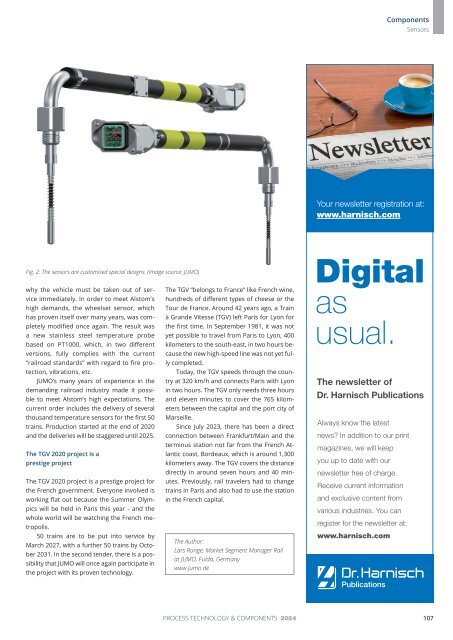PuK - Process Technology & Components 2024
A technical trade magazine with a history of more than 60 years.
A technical trade magazine with a history of more than 60 years.
Create successful ePaper yourself
Turn your PDF publications into a flip-book with our unique Google optimized e-Paper software.
<strong>Components</strong><br />
Sensors<br />
Your newsletter registration at:<br />
www.harnisch.com<br />
Fig. 2: The sensors are customised special designs. (Image source: JUMO)<br />
why the vehicle must be taken out of service<br />
immediately. In order to meet Alstom’s<br />
high demands, the wheelset sensor, which<br />
has proven itself over many years, was completely<br />
modified once again. The result was<br />
a new stainless steel temperature probe<br />
based on PT1000, which, in two different<br />
versions, fully complies with the current<br />
“railroad standards” with regard to fire protection,<br />
vibrations, etc.<br />
JUMO’s many years of experience in the<br />
demanding railroad industry made it possible<br />
to meet Alstom’s high expectations. The<br />
current order includes the delivery of several<br />
thousand temperature sensors for the first 50<br />
trains. Production started at the end of 2020<br />
and the deliveries will be staggered until 2025.<br />
The TGV 2020 project is a<br />
prestige project<br />
The TGV 2020 project is a prestige project for<br />
the French government. Everyone involved is<br />
working flat out because the Summer Olympics<br />
will be held in Paris this year - and the<br />
whole world will be watching the French metropolis.<br />
50 trains are to be put into service by<br />
March 2027, with a further 50 trains by October<br />
2031. In the second tender, there is a possibility<br />
that JUMO will once again participate in<br />
the project with its proven technology.<br />
The TGV “belongs to France” like French wine,<br />
hundreds of different types of cheese or the<br />
Tour de France. Around 42 years ago, a Train<br />
à Grande Vitesse (TGV) left Paris for Lyon for<br />
the first time. In September 1981, it was not<br />
yet possible to travel from Paris to Lyon, 400<br />
kilometers to the south-east, in two hours because<br />
the new high-speed line was not yet fully<br />
completed.<br />
Today, the TGV speeds through the country<br />
at 320 km/h and connects Paris with Lyon<br />
in two hours. The TGV only needs three hours<br />
and eleven minutes to cover the 765 kilometers<br />
between the capital and the port city of<br />
Marseille.<br />
Since July 2023, there has been a direct<br />
connection between Frankfurt/Main and the<br />
terminus station not far from the French Atlantic<br />
coast, Bordeaux, which is around 1,300<br />
kilometers away. The TGV covers the distance<br />
directly in around seven hours and 40 minutes.<br />
Previously, rail travelers had to change<br />
trains in Paris and also had to use the station<br />
in the French capital.<br />
The Author:<br />
Lars Ronge, Market Segment Manager Rail<br />
at JUMO, Fulda, Germany<br />
www.jumo.de<br />
Digital<br />
as<br />
usual.<br />
The newsletter of<br />
Dr. Harnisch Publications<br />
Always know the latest<br />
news? In addition to our print<br />
magazines, we will keep<br />
you up to date with our<br />
newsletter free of charge.<br />
Receive current information<br />
and exclusive content from<br />
various industries. You can<br />
register for the newsletter at:<br />
www.harnisch.com<br />
PROCESS TECHNOLOGY & COMPONENTS <strong>2024</strong><br />
107

















